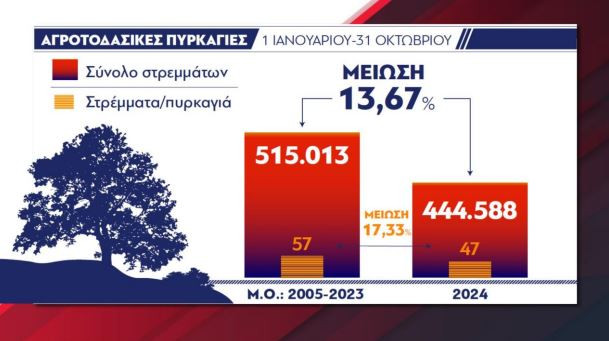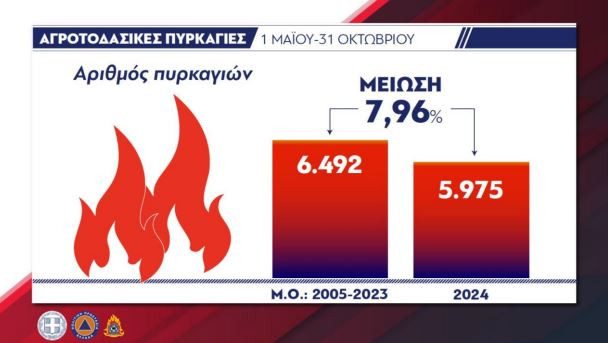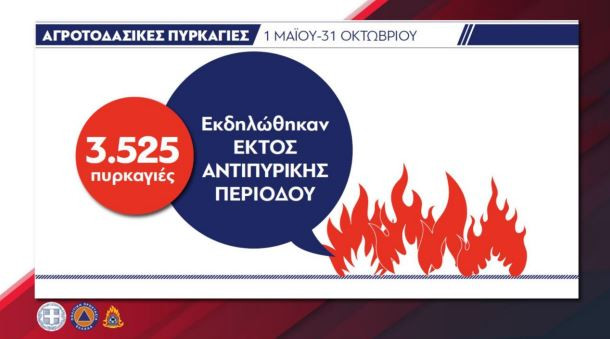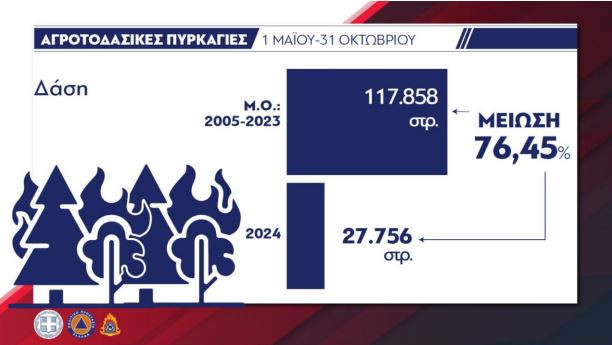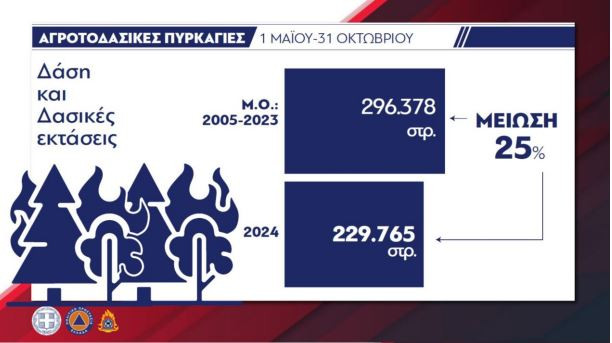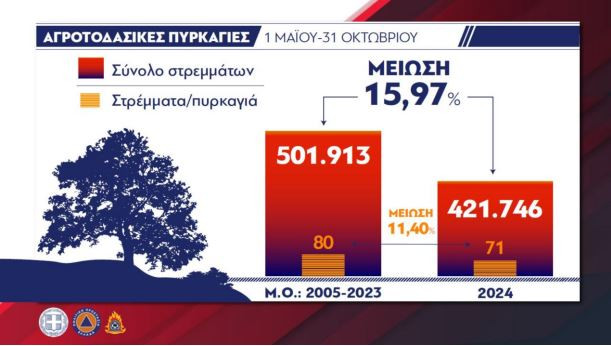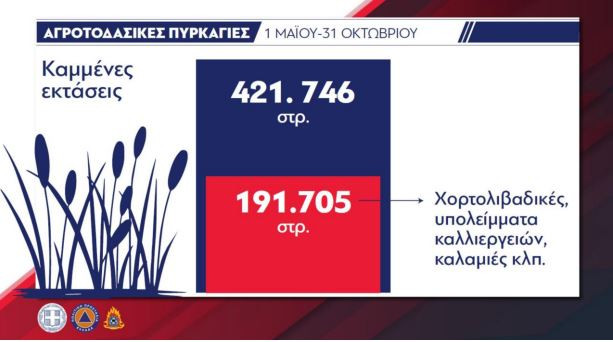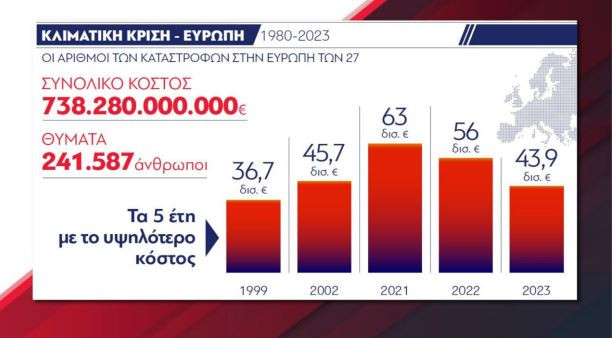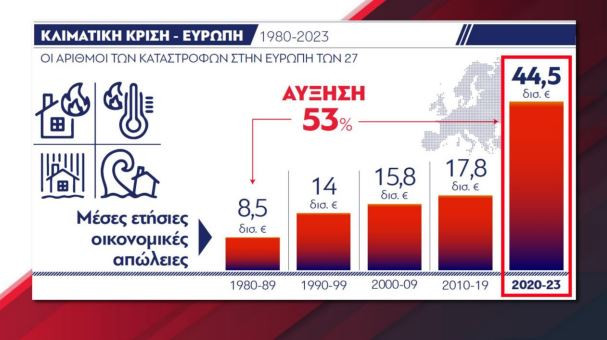2024 was one of the driest years, and from spring onwards, the annual total precipitation deficit exceeds 40-50% of the last 34-year average
An event on the evaluation of this year’s fire season was held today at the Ministry of Climate Crisis and Civil Protection, in the presence of Prime Minister Kyriakos Mitsotakis.
In the context of the event, 13 natural and legal persons, 2 Regions and 13 Municipalities were awarded for donating – through financing – services for leasing operational centers of unmanned aircraft (drones).
The speech of the Minister of Climate Crisis and Civil Protection, Vassilis Kikilia, in detail:
“Permit me to give a special shout out to the uniformed men and women of Civil Protection, present and absent from this room, but always present in battle.
It is your dedication to duty, your many times superhuman effort, your honor, which together with the volunteers, every year protects people, property and the natural environment. And we thank you all sincerely.
Another big thank you on behalf of all of us, for the uniformed armed forces of the ground and air forces, the Police and the Coast Guard, for the self-governing and specialist scientists, in other words this great interfunctional team, which this year, both in prevention and against during the fires, it worked great.
Ladies and Gentlemen,
This year’s fire protection season, details of which we will present below, unfolded with the following data:
First, 2024 was one of the driest years. From spring onwards, the deficit of annual total precipitation exceeds 40-50% compared to the average value of the last 34 years. What this means for the risk of wildfires in forested areas doesn’t even need to be explained I think…
Second, 2024 was the warmest year on record. Record-breaking maximum temperatures were recorded in months such as April, June, and July with a multi-day record-breaking heat wave of 16 days. It should be noted that the immediately preceding multi-day heatwave lasting 15 days occurred in 2023. In other words, we have two consecutive years – an unprecedented fact.
Thirdly, in 2024 we had a very high number of fires occurring outside the fire protection season, i.e. before May 1 and after October 31. A phenomenon that occurs with great frequency in recent years.
Taking into account, therefore, the data of the previous years, and with the certainty that the climate crisis is and will be here, Civil Protection proceeded to redesign its operational arm in terms of dealing with fires and the new doctrine of the Fire Department, focusing on prevention, interoperability, the strengthening of EMODE, surveillance, preparedness and the immediate mobilization of air and ground forces forces.
Add to these the wider government policy, where together with the co-competent Ministries of Justice, Energy and Environment, we tightened the penalties for arsonists, legislated the cleaning of plots of land – and the citizens responded impressively – that is, we moved decisively and continue with a series of preventive actions.
Now, the implementation of the new doctrine of the Fire Department, combined with the now extensive use of new technological tools, such as drones and the upgraded ESKEDIK, worked overall to a very satisfactory degree.
Were all fires dealt with? No, and as you all here know, that is literally impossible. Especially under extreme conditions of high temperatures and strong winds, forest and peri-urban forest fires have been and will be the biggest nightmare of fire brigades.
I would venture to say, however, that based on the very large number of extremely dangerous wildfire outbreaks dealt with quickly and effectively this fire season, the new doctrine has been a literal lifesaver. In the sense that if
even 5% of them escaped, today we would do a different kind of reckoning. And this we must recognize and credit to all those who gave their souls in these battles.
So, let’s get down to the facts and start with the whole year.
From January 1 to October 31 we had a 7.42% increase in the number of fires compared to the 20-year average: 8,844 fires are the MO, and 9,500 in 2024.
However, even though we had more starts, we had a reduction of acres burned in total by 13.67%. That is, 515,000 acres the 20-year MO, 444,500 acres in 2024.
Let’s now look at the basic elements of this year’s fire season, from May 1 to October 31, and the corresponding comparisons. As you can see here, there is a decrease of about 8% in the number of fires compared to the 20-year data: 6,492 is the Average during the fire season and 5,975 fires respectively in 2024.
Here I want to emphasize, because it is very likely that we will face it much more often in the future, an alarming fact: The large number of fires outside the non-fire season: Out of the 9,500 total fires in 2024, 3,525 occurred before or after the non-fire season with that implies.
And in this slide you see the most important achievement of this year’s fire season, after the protection of human life: A 76.45% reduction in burned forests. So this year, thanks to your own actions, and not because it was a good, mild year, we have 27,756 acres of burned forest against 117,858 acres which is the twenty-year MO.
I want to emphasize the importance of these elements you see: Because in the tripartite fire risk assessment “human life-property-environment” forests are the heavy factor for the environment
But also cumulatively, i.e. Forests and Woodlands – where by forest lands we mean the low vegetation, bushes, holly trees, briars, coppices, etc., which have immediate natural regeneration as you know – we have a 25% reduction compared to the 20-year MO.
Overall in the fire season from May 1 – October 31 there is a 15.97% reduction of all types of burned areas: 500,000 acres is the 20-year MO, 421,000 acres in 2024 and respectively 80 and 71 acres per fire. However, as you will see soon after…
Of the 421,476 acres of burned land, 45% that is, 191,000 acres are grasslands, residues, reeds, etc. This is how the very large reductions of burned forests and forest areas that we saw earlier in relation to the total number of acres are explained.
As I said at the beginning, 2024 was a very difficult year. It was the worst year in terms of fire-meteorological conditions in the last 40 years.
Specifically: It has not rained or snowed since the beginning of the year, while it was preceded by an arid winter in 2023. An increase in the average temperatures of all months from 2 to 4 degrees Celsius was recorded.
An early appearance of the meltems was observed, which maintained high intensities during the night, i.e. they did not leave a “window” for the fire to subside in the evenings.
We had intense drought even at high altitudes, 1,800 and 2,000 meters, such as: Mount Papikio, Orvylos, Pangaeo (2 fires), Mount Falakro, Pieria mountains (2 fires, one at the end of March), Olympus (3 fires), Menoikio, Snow village etc.
And, as you can see in the table, the fire danger indicators were at their highest levels ever.
- For the first time it appeared in the month of June, red alert indicator (5).
- We had 78 days with high index-yellow (3). 35.7% increase compared to the 15-year M.O.
- 57 days with a very high risk index-orange (4). 93% increase compared to M.O. of 15 years.
- 3 days with red (5) alert fire hazard indicator. That is, a 221% increase compared to the 20-year average.
What emerges from all the data, the estimates of scientists and experts, but also our own experience is that climate change has already become a climate crisis
In the last 45 years in Europe of 27, 241,587 people lost their lives due to natural disasters, while the cost of the damage amounted to 738 billion 280 million euros. See
that of the 5 years with the highest costs, the 3 consecutive ones are 2021, 2022 and 2023.
And look where we’re going…
We are moving into a new dystopian reality, which we must, however, manage by protecting people, property, infrastructure and the environment. From the 80s to today we have a 53% increase in average annual economic losses with a geometrical rise.
Ladies and Gentlemen, this government since 2019 laid the foundations and then created the institutional framework and infrastructure, so that the State has the means, the mechanisms and the ability to deal with crises, to protect citizens and the environment.
I will not repeat the familiar. I will only say that this laborious effort with the establishment of the Ministry, the institutional redesign of responsibilities, the flagship AEGIS program of 2.1 billion and the continuous investment in human resources, is a top strategic choice of Kyriakos Mitsotakis that is already being vindicated”.
The following individuals/legal entities were awarded for the donation – through funding – of drone operational center rental services:
HELLENIQ ENERGY HOLDINGS SA, HELLENIC ASSOCIATION OF BANKS, NON-PROFIT COMPANY, ASSOCIATION (Social Offer Company of Hellenic Armaments), FOUNDATION
CAPTAIN VASILIS & CARMEN KONSTANTAKOPOULOU, ANDONIS AND MARIKA LEMOS MUNICIPAL NON-PROFIT COMPANY, ROLEX HELLAS, ADMIE SA, MOTOR OIL HELLAS SA, AVIS BUDGET, D. MASOUTIS SA, MACEDONIA-THRAKIS BREWERY SA. and Rodolfo Odoni.
as well as the following Regions and Municipalities:
Region of Eastern Macedonia and Thrace, PE of Evia, Municipality of Penteli, Municipality of Marathon, Municipality of Kifissia, Municipality of Aigaleo, Municipality of Aspropyrgos, Municipality of Vari-VoulasVouliagmenis, Municipality of Galatsi, Municipality of Dionysos, Municipality of Evrotas, Municipality of Loutraki, Municipality of Xanthi, Municipality of Pylaia and Municipality Tribal.
The company VANGARD SECURITY was also awarded for its services
Source: Skai
I have worked as a journalist for over 10 years, and my work has been featured on many different news websites. I am also an author, and my work has been published in several books. I specialize in opinion writing, and I often write about current events and controversial topics. I am a very well-rounded writer, and I have a lot of experience in different areas of journalism. I am a very hard worker, and I am always willing to put in the extra effort to get the job done.


